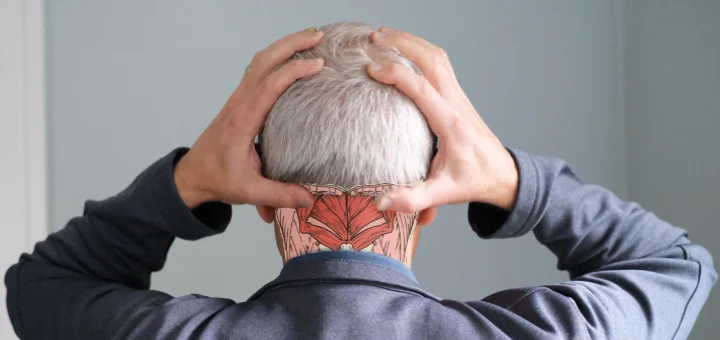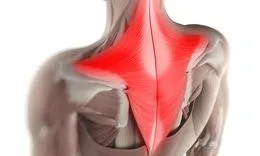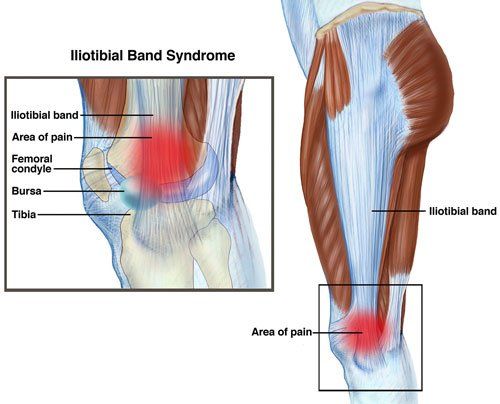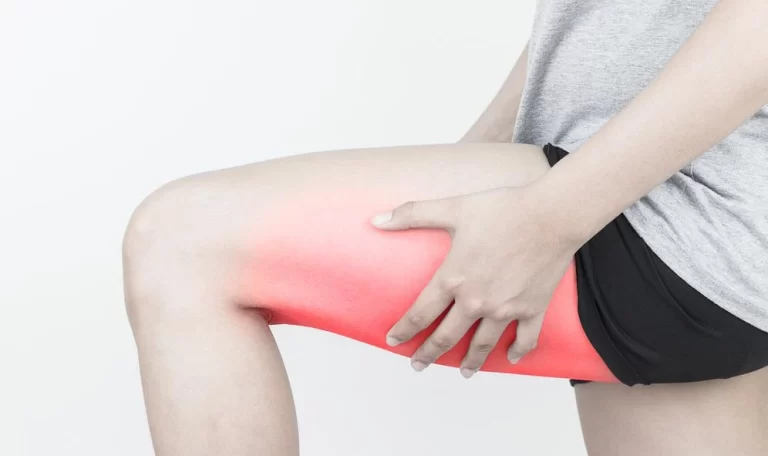Suboccipital Headache: Physiotherapy Treatment, Exercise
What is a Suboccipital Headache?
A suboccipital headache is a type of headache that is typically characterized by pain in the back of the head, near the base of the skull. The suboccipital region is the area at the base of the skull where the cervical spine (neck) meets the skull.
Suboccipital headaches are usually caused by tension or strain in the muscles of the neck and upper back, and they can be triggered by activities such as prolonged sitting or standing, poor posture, or stress. In addition to pain in the back of the head, suboccipital headaches may also cause pain or stiffness in the neck, shoulders, and upper back, as well as sensitivity to light or sound, dizziness, or nausea. Treatment for suboccipital headaches may include physical therapy, massage, medication, or other interventions to help reduce muscle tension and relieve pain.
Related Anatomy
The suboccipital region is located at the base of the skull and includes the muscles, bones, nerves, and blood vessels in this area. Some of the anatomical structures in this region include:
Occipital bone: The occipital bone is a flat bone at the back of the skull that forms the base of the skull and protects the brainstem.
Atlas and axis vertebrae: The atlas (C1) and axis (C2) vertebrae are the first two vertebrae of the cervical spine, and they form a joint that allows the head to rotate and tilt.
Suboccipital muscles: The suboccipital muscles are a group of four muscles located at the base of the skull that helps to stabilize the head and neck and control movement.
Greater occipital nerve: The greater occipital nerve is a sensory nerve that originates in the upper cervical spine and supplies the skin on the back of the head and neck.
Vertebral arteries: The vertebral arteries are two large blood vessels that run through the cervical spine and supply blood to the brainstem and cerebellum.
In suboccipital headaches, tension or strain in the suboccipital muscles can lead to irritation of the greater occipital nerve and other structures in this region, causing pain and other symptoms.
Causes of Suboccipital Headache
Suboccipital headaches are typically caused by tension and strain in the muscles of the neck and upper back, which can lead to irritation of the nerves and blood vessels in the suboccipital region. Some of the common causes of suboccipital headaches include:
Poor posture: Prolonged sitting or standing in a position that places strain on the neck and upper back can lead to tension in the suboccipital muscles.
Stress: Emotional stress and anxiety can cause tension in the muscles of the neck and upper back, leading to suboccipital headaches.
Muscle imbalances: Weakness or tightness in the muscles of the neck and upper back can cause muscle imbalances that lead to tension in the suboccipital muscles.
Injury: Trauma to the neck or head, such as whiplash or a concussion, can cause suboccipital headaches.
Arthritis: Arthritis in the cervical spine can cause suboccipital headaches due to inflammation and degeneration of the joints and soft tissues in this region.
Tension headaches: Tension headaches are a common type of headache that can cause pain and tension in the suboccipital region.
Temporomandibular joint (TMJ) dysfunction: TMJ dysfunction can cause pain and tension in the muscles of the neck and upper back, leading to suboccipital headaches.
Treatment for suboccipital headaches may involve addressing the underlying cause of the tension and strain in the suboccipital region, such as physical therapy, medication, or lifestyle changes.
Symptoms of Suboccipital Headache
Suboccipital headaches are characterized by pain in the back of the head, near the base of the skull. However, there are other symptoms that may be associated with suboccipital headaches. These include:
Pain: Pain in the suboccipital region is the primary symptom of suboccipital headaches. The pain is typically described as a dull, aching sensation that is localized to the back of the head and upper neck.
Stiffness: Stiffness in the neck and upper back is a common symptom of suboccipital headaches. This stiffness may be accompanied by a limited range of motion and difficulty moving the head and neck.
Sensitivity to light and sound: Some people with suboccipital headaches may experience sensitivity to light and sound. This sensitivity may be more pronounced during a headache episode.
Dizziness: Dizziness and lightheadedness are common symptoms of suboccipital headaches. These symptoms may be related to tension and strain in the neck and upper back muscles.
Nausea: Nausea and vomiting are less common symptoms of suboccipital headaches, but they may occur in some cases.
Tingling or numbness: Some people with suboccipital headaches may experience tingling or numbness in the scalp or neck. This may be related to irritation of the nerves in the suboccipital region.
It is important to note that the symptoms of suboccipital headaches can vary from person to person, and some people may experience only a few of these symptoms. If you are experiencing persistent or severe headaches, it is important to see a healthcare provider for an accurate diagnosis and appropriate treatment.
Diagnosis
To diagnose suboccipital headaches, a healthcare provider will typically start by taking a thorough medical history and conducting a physical examination. During the physical exam, the provider will assess the neck and upper back muscles for tenderness, tightness, and other signs of tension or strain. They may also check for a limited range of motion in the neck and perform neurological tests to assess nerve function.
In some cases, imaging studies such as X-rays, CT scans, or MRI may be ordered to rule out other underlying conditions that may be causing the headaches, such as a cervical spine injury, arthritis, or a tumor.
It is important to note that suboccipital headaches are a common type of headache and are typically not associated with serious underlying medical conditions. However, if the headache is severe or accompanied by other symptoms such as fever, weakness, or numbness, it is important to seek medical attention right away, as these symptoms may be indicative of a more serious underlying condition.
Once a diagnosis of suboccipital headache has been made, treatment may involve a combination of medication, physical therapy, massage, and lifestyle changes to address the underlying causes of tension and strain in the neck and upper back muscles.
Treatment of Suboccipital Headache
The treatment of suboccipital headaches typically involves addressing the underlying causes of tension and strain in the neck and upper back muscles. Some common treatment options include:
Medication: Over-the-counter pain relievers such as ibuprofen or acetaminophen may help alleviate the pain associated with suboccipital headaches. In some cases, prescription medications such as muscle relaxants or triptans may be recommended.
Physical therapy: Physical therapy can help strengthen the muscles of the neck and upper back, improve posture, and increase the range of motion in the neck. A physical therapist may recommend exercises, stretches, and other techniques to alleviate tension and strain in the suboccipital region.
Massage therapy: Massage therapy can help alleviate tension and promote relaxation in the neck and upper back muscles. A massage therapist may use techniques such as deep tissue massage or trigger point therapy to target the suboccipital muscles.
Lifestyle changes: Lifestyle changes such as maintaining good posture, reducing stress, getting regular exercise, and avoiding prolonged sitting or standing in one position may help alleviate tension and strain in the neck and upper back muscles.
Acupuncture: Acupuncture involves the insertion of thin needles into specific points of the body to alleviate pain and promote relaxation. Some people with suboccipital headaches may find acupuncture helpful in reducing pain and tension.
It is important to note that the treatment of suboccipital headaches may vary depending on the individual and the underlying causes of the headaches. It is recommended to consult with a healthcare provider to develop an individualized treatment plan.
Physiotherapy treatment
Physiotherapy can be an effective treatment for suboccipital headaches, as it focuses on addressing the underlying causes of tension and strain in the neck and upper back muscles. A physiotherapist may recommend a combination of exercises, manual therapy, and other techniques to alleviate pain and improve the range of motion in the neck.
Some common physiotherapy treatments for suboccipital headaches include:
Neck exercises: Neck exercises can help strengthen the muscles of the neck and upper back, improve posture, and increase range of motion in the neck. A physiotherapist may recommend exercises such as neck stretches, shoulder shrugs, and chin tucks.
Manual therapy: Manual therapy techniques such as massage, trigger point therapy, and joint mobilization can help alleviate tension and improve flexibility in the suboccipital region. A physiotherapist may use these techniques to target specific areas of tension in the neck and upper back muscles.
Posture education: Poor posture can contribute to tension and strain in the neck and upper back muscles, leading to suboccipital headaches. A physiotherapist can provide education on proper posture and recommend exercises and stretches to improve posture.
Heat or cold therapy: Applying heat or cold to the neck and upper back muscles can help reduce pain and tension. A physiotherapist may recommend using a heating pad or ice pack to alleviate symptoms.
TENS therapy: Transcutaneous electrical nerve stimulation (TENS) therapy involves the use of low-level electrical currents to stimulate the nerves and alleviate pain. A physiotherapist may recommend TENS therapy for suboccipital headaches.
It is important to note that the specific physiotherapy treatments recommended may vary depending on the individual and the underlying causes of the headaches. A physiotherapist can work with the individual to develop an individualized treatment plan.
Exercises
There are a variety of exercises that can help alleviate tension and strain in the neck and upper back muscles, which can contribute to suboccipital headaches. Some exercises that may be recommended by a physiotherapist include:
Neck stretches: Gently tilt the head to the side and hold for 10-15 seconds, then repeat on the other side. Gently tilt the head forward and hold for 10-15 seconds, then tilt the head back and hold for 10-15 seconds.
Shoulder shrugs: Raise the shoulders up towards the ears, hold for a few seconds, then relax the shoulders back down.
Chin tucks: Sit with good posture and gently tuck the chin towards the chest while keeping the shoulders relaxed. Hold for a few seconds, then release.
Scapular retraction: Sit with good posture and gently squeeze the shoulder blades together, while keeping the shoulders relaxed. Hold for a few seconds, then release.
Upper trapezius stretch: Gently tilt the head to one side, while reaching the opposite arm overhead and gently pulling the head towards the shoulder. Hold for 10-15 seconds, then repeat on the other side.
Levator scapulae stretch: Gently tilt the head to one side, while reaching the same-side arm behind the back and gently pulling the head towards the opposite shoulder. Hold for 10-15 seconds, then repeat on the other side.
It is important to note that the specific exercises recommended may vary depending on the individual and the underlying causes of the headaches. It is recommended to consult with a healthcare provider or physiotherapist to develop an individualized exercise plan.
How to Prevent Suboccipital Headache?
There are several steps you can take to help prevent suboccipital headaches:
Practice good posture: Poor posture can put extra strain on the neck and upper back muscles, leading to suboccipital headaches. Make sure to sit and stand with good posture, keeping the shoulders back and the head aligned with the spine.
Take frequent breaks: If you sit or stand in one position for long periods of time, this can contribute to tension and strain in the neck and upper back muscles. Make sure to take frequent breaks and move around throughout the day.
Stretch regularly: Regular stretching can help prevent tension and strain in the neck and upper back muscles. Consider incorporating stretches into your daily routine, especially if you spend a lot of time sitting or working on a computer.
Exercise regularly: Regular exercise can help improve posture, strengthen the muscles of the neck and upper back, and reduce stress. Aim for at least 30 minutes of exercise most days of the week.
Manage stress: Stress can contribute to tension in the neck and upper back muscles, leading to suboccipital headaches.
Consider practicing relaxation techniques such as deep breathing, meditation, or yoga to help manage stress.
Maintain a healthy diet: Certain foods, such as those containing caffeine or artificial sweeteners, may trigger headaches in some people. Consider keeping a headache diary to help identify potential triggers and make changes to your diet as needed.
Get enough sleep: Lack of sleep can contribute to headaches in some people. Aim for 7-9 hours of sleep per night, and establish a regular sleep routine.
It is important to note that the specific prevention strategies may vary depending on the individual and the underlying causes of the headaches. It is recommended to consult with a healthcare provider to develop an individualized prevention plan.
Conclusion
Suboccipital headaches can be a source of discomfort and pain for many individuals and can be caused by a variety of factors such as tension and strain in the neck and upper back muscles, poor posture, stress, and other underlying conditions.
Treatment may include physiotherapy, medications, or other interventions to address the underlying cause of the headaches. In addition, there are steps that can be taken to prevent suboccipital headaches, such as practicing good posture, taking frequent breaks, stretching regularly, exercising, managing stress, maintaining a healthy diet, and getting enough sleep. It is important to consult with a healthcare provider to determine the best course of treatment and prevention for individual cases of suboccipital headaches.
FAQ
What does a Suboccipital Headache feel like?
A suboccipital headache typically feels like a dull, aching pain that is located at the base of the skull, near the suboccipital
muscles. The pain may radiate to the sides of the head, behind the eyes, or to the forehead. The headache may be accompanied by neck pain or stiffness and may be worsened by certain movements or positions of the head and neck.
Some people may also experience other symptoms with suboccipital headaches, such as sensitivity to light or sound, dizziness, or nausea.
The severity and duration of suboccipital headaches can vary depending on the underlying cause of the headache and other individual factors.
It is important to note that suboccipital headaches may be similar in nature to other types of headaches, such as tension
headaches or cervicogenic headaches, and a proper diagnosis is important to determine the appropriate treatment plan. If you are experiencing headaches or other concerning symptoms, it is recommended to consult with a healthcare provider.
How do you stop a Suboccipital Headache?
There are several ways to stop a suboccipital headache:
Identify and address the underlying cause: If the headache is caused by tension or strain in the suboccipital muscles, addressing the underlying cause may help to relieve the headache. This may include stretching, massage, or postural adjustments.
Pain relief medication: Over-the-counter pain relief medication such as ibuprofen or acetaminophen may help to relieve the pain of a suboccipital headache. However, it is important to use these medications as directed and not to rely on them as a long-term solution.
Apply heat or cold: Applying a hot or cold compress to the affected area may help to reduce pain and inflammation. Cold
therapy may be more effective in the first 48 hours after the headache starts, while heat therapy may be more effective after this period.
Relaxation techniques: Practicing relaxation techniques such as deep breathing, meditation, or yoga may help to reduce stress and tension, which can contribute to suboccipital headaches.
Consult a healthcare provider: If the headache persists or is severe, it is important to consult with a healthcare provider to
determine the underlying cause and appropriate treatment plan.
It is important to note that the most effective way to stop a suboccipital headache may depend on the underlying cause and
individual factors. It is recommended to consult with a healthcare provider to determine the most appropriate treatment plan for your specific situation.
Can massage fix Suboccipital Headache?
Massage can be an effective treatment for suboccipital headaches caused by tension and tightness in the suboccipital muscles.
Massage can help to relieve muscle tension and improve circulation, which can help to alleviate headaches. Additionally,
massage can help to promote relaxation and reduce stress, which can also contribute to suboccipital headaches.
It is important to note that the effectiveness of massage for suboccipital headaches may depend on the underlying cause of the headaches. If the headaches are caused by an underlying condition, such as a neck injury or cervical spine issue, massage may not be effective and may even be contraindicated. It is important to consult with a healthcare provider to determine the underlying cause of the headaches and the most appropriate treatment plan. If massage is recommended, it is important to seek treatment from a licensed and experienced massage therapist.
How do you release tight Suboccipital muscles?
There are several techniques that can be used to release tight suboccipital muscles:
Massage: Gentle massage of the suboccipital muscles can help to relieve tension and promote relaxation. This can be done by a trained therapist or by using a massage tool, such as a foam roller or massage ball.
Stretching: Stretching the suboccipital muscles can help to relieve tension and improve flexibility. One effective stretch is to sit with good posture and gently tuck the chin towards the chest while keeping the shoulders relaxed. Hold for a few seconds, then release.
Trigger point release: Trigger points, or areas of muscle tension and tenderness, can contribute to suboccipital headaches.
Using a lacrosse ball or foam roller to apply pressure to these areas can help to release tension and reduce pain.
Heat therapy: Applying heat to the suboccipital muscles can help to promote relaxation and improve blood flow. This can be
done using a hot towel, heat pack, or warm shower.
Posture correction: Poor posture can contribute to tension in the suboccipital muscles. Making a conscious effort to sit and
standing with good posture can help to relieve tension and prevent future headaches.
It is important to note that the specific techniques used may vary depending on the individual and the underlying causes of the tension in the suboccipital muscles. It is recommended to consult with a healthcare provider or physiotherapist to develop an individualized treatment plan.








4 Comments